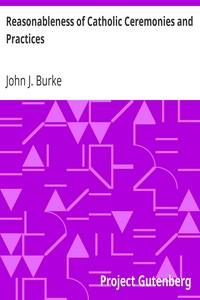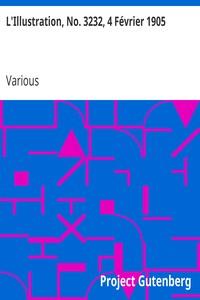|
|
Read this ebook for free! No credit card needed, absolutely nothing to pay.Words: 21611 in 7 pages
This is an ebook sharing website. You can read the uploaded ebooks for free here. No credit cards needed, nothing to pay. If you want to own a digital copy of the ebook, or want to read offline with your favorite ebook-reader, then you can choose to buy and download the ebook.

: Reasonableness of Catholic Ceremonies and Practices by Burke John J John James - Catholic Church Customs and practices; Sacraments Catholic Church; Sacramentals@FreeBooksWed 07 Jun, 2023 White, which is symbolic of purity and innocence, is used on the feasts of Our Lord, of the Blessed Virgin, of the angels, and of the saints that were not martyrs. Red, the symbol of fortitude, is used on the feast of Pentecost, of the Exaltation of the Cross, of the apostles and martyrs. Purple, or violet , is used in Advent and Lent. Green is used on all Sundays when no special feast is celebrated, except the Sundays of Lent and Advent. Black is used on Good Friday and during the celebration of Mass for the dead. Thus we see that each vestment and color used has a special significance. All are calculated to attract our attention, elevate our minds to God, and fill us with a desire to do something for Him Who has done so much for us--to at least keep His commandments. One word about the use of Latin in the celebration of Mass will perhaps be appropriate here. History tells us that when Christianity was established the Roman Empire had control of nearly all of Europe, Asia, and Africa. Wherever the Roman flag floated to the breeze the Latin language was spoken, just as English is spoken where the sovereign of Great Britain or the President of the United States holds sway. The Church naturally adopted in her liturgy the language spoken by the people. In the beginning of the fifth century vast hordes of barbarians began to come from the north of Europe and spread desolation over the fairest portions of the Roman Empire. Soon the Empire was broken up. New kingdoms began to be formed, new languages to be developed. The Latin finally ceased to be a living language. The Church retained it in her liturgy, 1st, because, as her doctrine and liturgy are unchangeable, she wishes the language of her doctrine and liturgy to be unchangeable; 2d, because, as the Church is spread over the whole world, embracing in her fold children of all climes, nations, and languages--as she is universal--she must have a universal language; 3d, because the Catholic clergy are in constant communication with the Holy See, and this requires a uniform language. Besides, when a priest says Mass the people, by their English Missals or other prayer-books, are able to follow him from beginning to end. The Mass is a sacrifice. The prayers of the Mass are offered to God. Hence when the priest says Mass he is speaking not to the people, but to God, to whom all languages are equally intelligible. Are not these sufficient reasons for the use of the Latin language? Are not good Catholics more attentive, more devout at Mass than others at their prayer-meetings? The good Catholic knows that the Mass represents the passion and death of Christ; that the passion and death of Christ are the sinner's only refuge, the just man's only hope; that it can not but be good and wholesome to turn our minds and our hearts toward this subject; that frequent meditation on Christ's passion will move us to avoid sin, which caused it; and that nothing can more efficaciously cause us to think of Christ's passion and death than the holy sacrifice of the Mass. THE Mass is the great sacrifice of the New Law. It was foreshadowed by all the sacrifices ordained by God in the Old Law. They were shadows; it is the substance. Free books android app tbrJar TBR JAR Read Free books online gutenberg More posts by @FreeBooks
: General Catholic Devotions by Hammer Bonaventure Compiler - Catholic Church Prayers and devotions@FreeBooksWed 07 Jun, 2023

: L'Illustration No. 3232 4 Février 1905 by Various - Illustrated periodicals France L'Illustration@FreeBooksWed 07 Jun, 2023
|
Terms of Use Stock Market News! © gutenberg.org.in2025 All Rights reserved.






